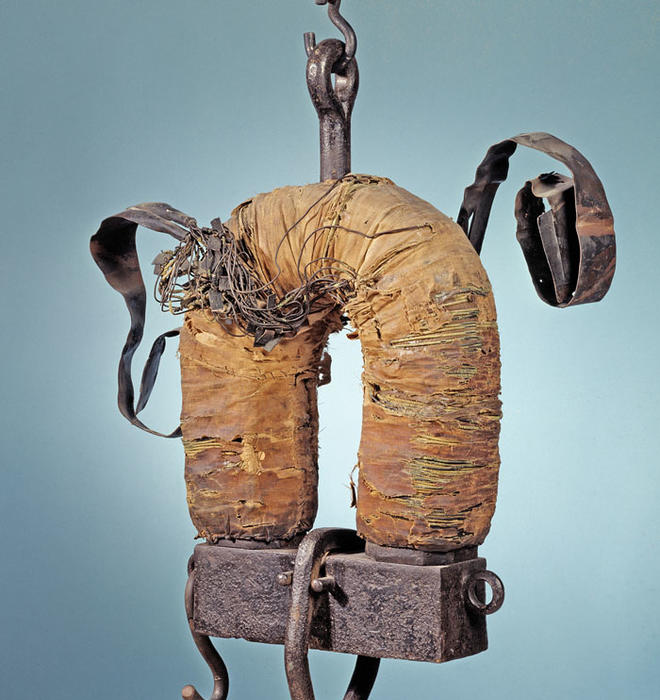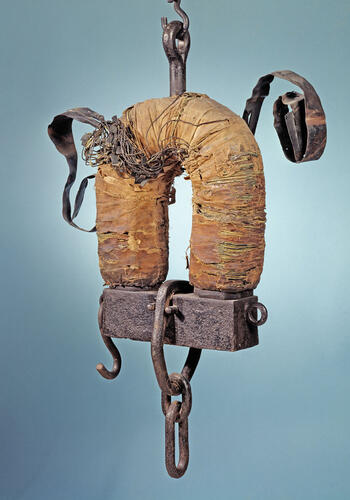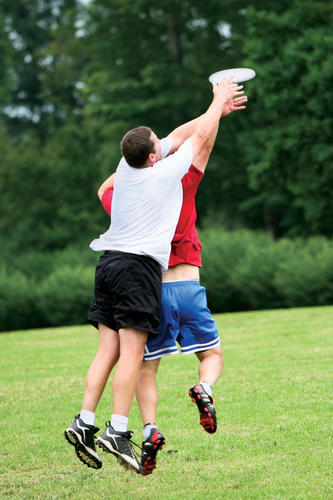
The Electromagnet--Joseph Henry
Henry, a professor of natural philosophy, was Princeton's best-known scientist in the 19th century. Biographers argue that he discovered induction before Michael Faraday (Faraday published his finding first), created a working telegraph before Samuel Morse (sending signals to his wifef over a wire from his Princeton lab to his nearby home), and detected radio waves before Heinrich hertz. One achievement beyond dispute is Henry's work to build stronger electromagnets. Using wire carefully wrapped in silk and cotton threads for insulation, he created magnets that could life p to 3,500 pounds--a monumental improvement over those previously available--and enabled advances in mining and other industries. Scientists still employ the Princeton professor's surman, which serves as a unit for measuring induction.
The "logical machine"--Allan Marquand 1874
The small wooden box on display in the Fine Hall Library bears no resemblance to today's laptop computers, but according to historians, Marquand's "logical machine" incorporated ideas that later became the foundation for complex digital devices. Working in the 1880s, Marquand used his arrangement of buttons, rods, and pins to simplify statements of Boolean logic, the algebraic system that underlies computer programming. The machine's outputs are binary, like the bits of a modern computer--each arrow on the machine points horizontally (on, or "1") or vertically (off, or "0"). While computer pioneers used similar principles, they did not draw directly from Marquand's work, which was largely forgotten. He became better known as the founder of (and a longtime professor in) Princeton's art and archaeology department.
The long-cane technique--C. Warren Bledsoe
Bledsoe was born on the grounds of the Maryland School for the Blind, where his father was superintendent, and he returned to the school after graduating from Princeton to teach English and work on his first novel, published in 1942. His experience teaching blind students would help him land an assignment in the Valley Forge Military Hospital during World War II, where he worked to help blinded soldiers regain enough mobility and independence to return home. With a military doctor, Richard Hoover, Bledsoe taught soldiers to use a long, lightweight cane to touch the surfaces in front of them. In the decades after the war, Bledsoe and his colleagues worked to spread their program of "orientation and mobility training" to schools and rehabilitation centers in the United States and around the world. Though he never achieved fame as a novelist, his work for the blind was widely appreciated. In 2002, he was inducted into the Hall of Fame for Leaders and Legends of the Blindness Field.
Synthetic cortisone--Lewis Sarett *42
Sarett studied chemical compounds for 38 years in Merck's pharmaceutical research labs, collecting dozens of patents, but his most significant discovery may have come in his first assignment. During World War II, just after receiving his Ph.D. in Chemistry, Sarett began working on a project to synthesize cortisone, a hormone that occurs naturally in very small amounts. Sarett completed a process that used a progression of 42 separate chemical reactions and produced a small amount of the valuable compound. Trials at the Mayo Clinic found that cortisone could be used to treat inflammatory disorders, such as rheumatoid arthritis and certain allergies. "it was overwhelming--to do the thing tI loved to do and have it proved useful to people," Sarett told The New York Times in 1980. "That's not possible in most professions."
Ultimate Frisbee--Jon Hines ’74
While alumni are well acquainted with Princeton's place in the origins of college football, few may know about its founding role in ultimate Frisbee. On Nov. 6, 1972, the 103rd anniversary f the first intercollegiate football game, students from Princeton and Rutgers faced off in the first inter-collegiate Frisbee match in New Brunswick (Princeton lost, 29-27). Jon Hines ’74, one of the players that day, created the sport in high school with friends Joel Silver, now famous for producing the Matrix and Die Hard moves, and Bernard Hellring ’74, who died in a car accident during his freshman year at Princeton. "We thought, 'We love this, and others will love this, too,'" says Hines, now a partner at a law firm in Moscow. But the game's growth in the last 35 years has surprised even its creators. In the United States, more than 800,000 people play ultimate Frisbee, according to a 2007 study by the Sporting Goods Manufacturers Association. Hines recently was invited to toss the ceremonial first disc at a competition in Russia.
Brett Tomlinson is an associate editor at PAW.











No responses yet